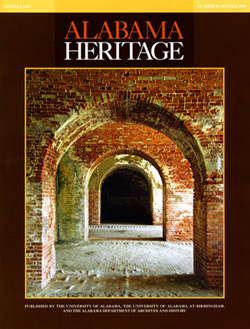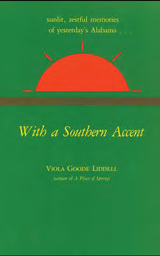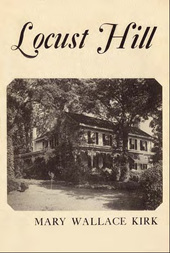|
On the cover: Fort Morgan's timeless casemate arches are showing the ravages of age. (Photo by Robin McDonald.)
|
FEATURE ABSTRACTS
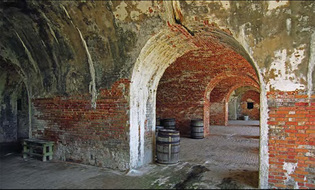 Water seepage and leaching lime cause slippery
Water seepage and leaching lime cause slipperyfloors and arch decay (Robin McDonald)
Fort Morgan: Guardian of the Bay
By Jessica Fordham Kidd
One of the South’s greatest military assets, Fort Morgan has protected the waters of Mobile Bay since its inception in 1834. Once its location gained attention for its beneficial strategic location, designs for a spectacular fort that could withstand the ravages of battle were put into place. Having overseen heavy action during the Civil War and World War II, the fort did its job of protecting our soldiers and harbor waters. Finally, however, the ravages of age are beginning to show on this historic landmark, and action is needed to protect the structure that protected so many throughout its past.
By Jessica Fordham Kidd
One of the South’s greatest military assets, Fort Morgan has protected the waters of Mobile Bay since its inception in 1834. Once its location gained attention for its beneficial strategic location, designs for a spectacular fort that could withstand the ravages of battle were put into place. Having overseen heavy action during the Civil War and World War II, the fort did its job of protecting our soldiers and harbor waters. Finally, however, the ravages of age are beginning to show on this historic landmark, and action is needed to protect the structure that protected so many throughout its past.
Additional Information
For further information on Fort Morgan, a visit to the historic landmark and its on-site museum is highly recommended. The landmark and museum preserve the history of all the eras of Fort Morgan. Other sources include Fort Morgan by Bob England, Jack Friend, Michael Bailey, and Blanton Blankenship (Arcadia Publishing, 2000),Confederate Forts by Zed H. Burns (Southern Historical Publications, 1977), and Two Naval Journals: 1864 edited by C. Carter Smith Jr. (Southern University Press, 1969).
The following articles in the Encyclopedia of Alabama will also be of interest:
About the Author
Jessica Fordham Kidd is a native of Coker, Alabama. She works as an assistant director of the First Year Writing program and as an instructor in the English department at the University of Alabama. She has a bachelor’s degree in geology and a master of fine arts degree in creative writing, both from the University of Alabama. Her article “Privation and Pride: Life in Blockaded Alabama” appeared in Alabama Heritage issue 82.
The author sends many thanks to Blanton Blankenship, site manager of Fort Morgan National Historic Landmark, and Michael Bailey, cultural resource coordinator at Fort Morgan. They provided extensive information on the fort’s history and preservation concerns, a tour of the site, and letters from soldiers stationed at Fort Morgan.
For further information on Fort Morgan, a visit to the historic landmark and its on-site museum is highly recommended. The landmark and museum preserve the history of all the eras of Fort Morgan. Other sources include Fort Morgan by Bob England, Jack Friend, Michael Bailey, and Blanton Blankenship (Arcadia Publishing, 2000),Confederate Forts by Zed H. Burns (Southern Historical Publications, 1977), and Two Naval Journals: 1864 edited by C. Carter Smith Jr. (Southern University Press, 1969).
The following articles in the Encyclopedia of Alabama will also be of interest:
- Fort Morgan and Gaines
- Battle of Mobile Bay
- CSS Nashville
- Creek Indian Removal
- Blockade Running in the Civil War
- Confederate Navy in Alabama
About the Author
Jessica Fordham Kidd is a native of Coker, Alabama. She works as an assistant director of the First Year Writing program and as an instructor in the English department at the University of Alabama. She has a bachelor’s degree in geology and a master of fine arts degree in creative writing, both from the University of Alabama. Her article “Privation and Pride: Life in Blockaded Alabama” appeared in Alabama Heritage issue 82.
The author sends many thanks to Blanton Blankenship, site manager of Fort Morgan National Historic Landmark, and Michael Bailey, cultural resource coordinator at Fort Morgan. They provided extensive information on the fort’s history and preservation concerns, a tour of the site, and letters from soldiers stationed at Fort Morgan.
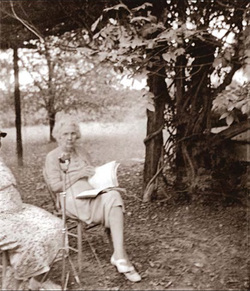 Ruby Pickens Tartt, 1940
Ruby Pickens Tartt, 1940(Library of Congress)
Ruby Pickens Tartt: Citizen of the World
By Philip Beidler and Elizabeth Buckalew
An extraordinary folklorist from Livingston in Sumter County, Ruby Pickens Tartt’s collection of slave narratives, folk songs, and interviews are vital documents that help unlock the history of Alabama’s past. A painter, librarian, matriarch, football fan (as well as somewhat of a danger behind the wheel of a car), Tartt lived a vivid and rich personal life filled with fortune. Yet she harnessed her enthusiasm for life into critical research that amounts to one of the most valuable collections of slave narratives to date. With empathy, candor, and purpose, Tartt ensured that the stories of Alabama's slaves would never be forgotten.
Additional Information
For more information on the WPA Slave Narratives, see the Library of Congress/American Memory website.
Additional Resources for Ruby Pickens Tartt and her folklore:
About the Author
Philip Beidler is a professor of English at the University of Alabama, where he has taught American literature since receiving his PhD from the University of Virginia in 1974. His publications over the years inAlabama Heritage include essays on Caroline Lee Hentz, Johnny Mack Brown, legal codes in early Alabama, and Alabama soldiers in the Vietnam War and the American Civil War. His most recent book isAmerican Wars, American Peace: Notes from a Son of the EmpireUniversity of Georgia Press (2007).
Elizabeth Wade Buckalew is an Assistant Editor for Alabama Heritage. A graduate of Davidson College, she is currently pursuing a PhD in English at the University of Alabama. Her poetry and nonfiction have appeared in such journals as Harpur Palate, Cream City Review,and Spoon River Poetry Review. She would like to thank Allen and Mary Tartt for their generous assistance with this article.
By Philip Beidler and Elizabeth Buckalew
An extraordinary folklorist from Livingston in Sumter County, Ruby Pickens Tartt’s collection of slave narratives, folk songs, and interviews are vital documents that help unlock the history of Alabama’s past. A painter, librarian, matriarch, football fan (as well as somewhat of a danger behind the wheel of a car), Tartt lived a vivid and rich personal life filled with fortune. Yet she harnessed her enthusiasm for life into critical research that amounts to one of the most valuable collections of slave narratives to date. With empathy, candor, and purpose, Tartt ensured that the stories of Alabama's slaves would never be forgotten.
Additional Information
For more information on the WPA Slave Narratives, see the Library of Congress/American Memory website.
Additional Resources for Ruby Pickens Tartt and her folklore:
- Arnold, Byron, ed. Folk Songs of Alabama. (U of Alabama Press, 1950). 151-156. Brown, Alan.
- _____. Dim Roads and Dark Nights: the Collected Folklore of Ruby Pickens Tartt. (U of Livingston Press, 1993).
- _____. and David Taylor, eds. Gabr’l Blow Sof’: Sumter County, Alabama, Slave Narratives. (U of Livingston Press, 1997).
- Brown, James Seay. Up Before Daylight: Life Histories from the Alabama Writers’ Project, 1938-39. (University of Alabama Press, 1982).
- Brown, Virginia Pounds and Laurella Owens. Toting the Lead Row: Ruby Pickens Tartt, Alabama Folklorist. (University of Alabama Press, 1981).
- Carmer, Carl. “Back to Alabama.” Holiday. 27 (March) 1960, 50-54+.
- _____. Stars Fell on Alabama. (The Literary Guild, 1934).
- _____. “My Most Unforgettable Character.” (Livingston University Press, 1975).
- Courlander, Harold. The Big Old World of Richard Creeks. (Chilton Company, 1962).
- Foley, Martha, ed. Best American Short Stories: 1945. (Houghton-Mifflin, 1945). 272-282.
- _____. Best American Short Stories: 1942. Introduction. (Houghton-Mifflin).
- _____ and A. A. Rothberg, eds. U. S. Stories: Regional Stories from the Forty-Eight States. (Farrar-Straus, 1949). 307-15.
- Jones, Tina Naremore. “Confronting the Big House and Other Stereotypes in the Short Stories of Ruby Pickens.” Tributaries 7.
- Lomax, Alan. The Rainbow Sign: A Southern Documentary. (Duell, Sloan, and Pearce, 1959).
- Lomax, John. Adventures of a Ballad Hunter. (Macmillan, 1947).
- Solomon, Jack, and Olivia Solomon, eds. Honey in the Rock: The Ruby Pickens Tartt Collection of Religious Folk Songs from Sumter County, Alabama. (Mercer University Press, 1992).
- Tartt, Ruby Pickens. “Alabama Sketches.” Southwest Review 29 (Winter) 1944, 234-41.
- _____. “Alice.” Southwest Review 33 (Spring) 1949, 192-195.
- _____. "Four Negro Stories.” Southwest Review 37 (Spring) 1952, 137-40.
- _____. Recorded Interview with Nathaniel Reed. 1964.
- _____. Recorded Interview with Nathaniel Reed. 1972.
- Texas Folklore Society. From Hell to Breakfast. (The Society, 1944). 21-28.
- Windham, Kathryn Tucker. Alabama: One Big Front Porch. (The Strode Publishers, Inc., 1957). 56-59.
About the Author
Philip Beidler is a professor of English at the University of Alabama, where he has taught American literature since receiving his PhD from the University of Virginia in 1974. His publications over the years inAlabama Heritage include essays on Caroline Lee Hentz, Johnny Mack Brown, legal codes in early Alabama, and Alabama soldiers in the Vietnam War and the American Civil War. His most recent book isAmerican Wars, American Peace: Notes from a Son of the EmpireUniversity of Georgia Press (2007).
Elizabeth Wade Buckalew is an Assistant Editor for Alabama Heritage. A graduate of Davidson College, she is currently pursuing a PhD in English at the University of Alabama. Her poetry and nonfiction have appeared in such journals as Harpur Palate, Cream City Review,and Spoon River Poetry Review. She would like to thank Allen and Mary Tartt for their generous assistance with this article.
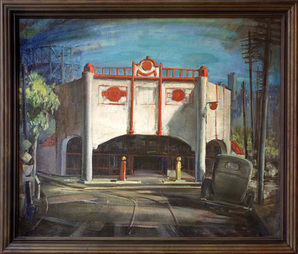 "No Nox"
"No Nox"Identified as the 3rd Avenue Filling Station
in Birmingham
(John Peter Crook McCall)
Richard Coe's Birmingham
By Lynn Barstis Williams
An accomplished artist whose studies took him all over the world, Richard Coe’s talent for painting and etching found a muse in the “Magic City” of Birmingham, where he focused on capturing the city and its residents during the Great Depression. His canvas gave true-to-life renditions of everything from steel mills to churches to multi-family dwellings.
Additional Information
Coe’s painting Birmingham Steel Mill can be viewed most recently inAmerican Paintings from the Montgomery Museum of Fine Arts (Montgomery Museum of Fine Arts, 2006). Two other etchings by Coe can be viewed in an essay by William U. Eiland, “Picturing the Unvictorious: The Southern Scene in Alabama, 1930-1946,” in The American Scene and the South: Paintings and Works on Paper, 1930-1946 (Georgia Museum, University of Georgia, 1996).
The following articles in the Encyclopedia of Alabama will also be of interest:
About the Author
Lynn Barstis Williams is Librarian Emerita at Auburn University Libraries. She is the author of Imprinting the South: Southern Printmakers and Their Images of the Region, 1920s-1940s (University of Alabama Press, 2007), various journal articles on southern art, and the compiler of American Printmakers: An Index to Reproductions and Biocritical Information, 1880-1945 (Scarecrow, 1993). She has authored other articles on Alabama artists for Alabama Heritage. Williams would like to thank John McCall for sharing his collection of Coe works for this article. She would be interested in hearing via email from people who have more knowledge of and works by Richard Coe.
By Lynn Barstis Williams
An accomplished artist whose studies took him all over the world, Richard Coe’s talent for painting and etching found a muse in the “Magic City” of Birmingham, where he focused on capturing the city and its residents during the Great Depression. His canvas gave true-to-life renditions of everything from steel mills to churches to multi-family dwellings.
Additional Information
Coe’s painting Birmingham Steel Mill can be viewed most recently inAmerican Paintings from the Montgomery Museum of Fine Arts (Montgomery Museum of Fine Arts, 2006). Two other etchings by Coe can be viewed in an essay by William U. Eiland, “Picturing the Unvictorious: The Southern Scene in Alabama, 1930-1946,” in The American Scene and the South: Paintings and Works on Paper, 1930-1946 (Georgia Museum, University of Georgia, 1996).
The following articles in the Encyclopedia of Alabama will also be of interest:
- John Kelly Fitzpatrick
- John Roderick Dempster MacKenzie
- Birmingham
- Sloss-Sheffield Steel and Iron Company (image)
About the Author
Lynn Barstis Williams is Librarian Emerita at Auburn University Libraries. She is the author of Imprinting the South: Southern Printmakers and Their Images of the Region, 1920s-1940s (University of Alabama Press, 2007), various journal articles on southern art, and the compiler of American Printmakers: An Index to Reproductions and Biocritical Information, 1880-1945 (Scarecrow, 1993). She has authored other articles on Alabama artists for Alabama Heritage. Williams would like to thank John McCall for sharing his collection of Coe works for this article. She would be interested in hearing via email from people who have more knowledge of and works by Richard Coe.
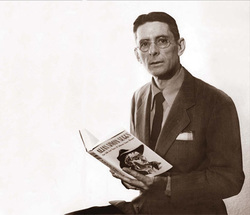 William Stanley Hoole
William Stanley Hoole(Elizabeth Hoole McArthur)
William Stanley Hoole: A Man of Letters
By Elizabeth Hoole McArthur
A legend on the University of Alabama campus, William Stanley Hoole is not just an Alabama icon but is also a revered scholar nationwide. Author, scholar, lecturer, and library administrator, Hoole held a great penchant for academia and the South. Beginning his first personal “library” at age four, Hoole grew up to make book collections one of the centermost facets in his life. As an innovative leader in the library sciences, Hoole was steadfast in his mission to improve the service and quality of university libraries, including a major overhaul at UA’s Tuscaloosa campus, where the collection he built is now a favorite of southern history scholars.
Additional Information
For further reading:
About Dr. William Stanley Hoole and the W.S. Hoole Special Collections Library:
By Dr. William Stanley Hoole (selections)
Dr. William Stanley Hoole as Series Editor-in-Chief and Contributing Author
The following articles in the Encyclopedia of Alabama will also be of interest:
Multimedia:
About the Author
Elizabeth Hoole McArthur, a Phi Beta Kappa graduate of the University of Alabama, earned BA and MA degrees in history. She holds the EdD from University of Georgia. Following a successful thirty-year career as a secondary school teacher/administrator she now writes for magazines, has published a history (Bound for Glory), and is completing another. She resides with her husband Hugh in Dalton, Georgia. McArthur has many wonderful childhood memories of “assisting” her father, Dr. Hoole, with his writings and eagerly accompanying him on searches for historic sites, relics, and stories as she grew older. With him she co-authored The Yankee Invasion of West Alabama, March–April, 1865. She would like to thank Mrs. Addie Shirley Hoole and Martha DuBose Hoole.
By Elizabeth Hoole McArthur
A legend on the University of Alabama campus, William Stanley Hoole is not just an Alabama icon but is also a revered scholar nationwide. Author, scholar, lecturer, and library administrator, Hoole held a great penchant for academia and the South. Beginning his first personal “library” at age four, Hoole grew up to make book collections one of the centermost facets in his life. As an innovative leader in the library sciences, Hoole was steadfast in his mission to improve the service and quality of university libraries, including a major overhaul at UA’s Tuscaloosa campus, where the collection he built is now a favorite of southern history scholars.
Additional Information
For further reading:
About Dr. William Stanley Hoole and the W.S. Hoole Special Collections Library:
- Hoole, Martha DuBose. William Stanley Hoole: Student-Teacher-Librarian-Author. Florida State University, 1958. Published as Number Twenty-eight in the reprint edition of Confederate Centennial Studies. Wilmington, North Carolina: Broadfoot Publishing Company, 2001.
- The Hoole Library
By Dr. William Stanley Hoole (selections)
- According to Hoole: The Collected Essays and Tales of a Scholar-Librarian and Literary Maverick. (University of Alabama Press, 1973).
- Alabama Tories: The First Alabama Cavalry, U.S.A., 1862-1865. Confederate Centennial Studies Number Sixteen. (Confederate Publishing Company, Inc., 1960).
- Alabama’s Boy Generals of the Confederacy. (Confederate Publishing Company, 1984). Co-authored with Addie Shirley Hoole.
- Alias Simon Suggs: The Life and Times of Johnson Jones Hooper. (University of Alabama Press, 1952).
- And Still We Conquer: The Diary of a Nazi Unteroffizier in the German Afrika Corps Who Was Captured by the United States Army, May 9, 1943 and Imprisoned at Camp Shelby, Mississippi. (Confederate Publishing Company, 1968). Edited with an Introduction.
- The Ante-Bellum Charleston Theatre. (University of Alabama Press, 1946).
- The Battle of Resaca, Georgia May 14-15, 1864. (Confederate Publishing Company, 1983). Co-authored with Hugh Lynn McArthur.
- The Birmingham Horrors. Being A Complete and Accurate Account of Richard R. Hawes’s Murder of His Wife Emma, and Daughters....(Strode Publishers, 1980).
- The Cherokee Indians in Georgia and Georgia in the 1840’s. (Confederate Publishing Company, 1980). Co-authored with Addie Shirley Hoole. Edited with a Foreword.
- Confederate Foreign Agent: The European Diary of Major Edward C. Anderson, C.S.A. (Confederate Publishing Company, 1976). Edited with a Prologue and an Epilogue.
- Confederate Norfolk: The Letters of a Virginia Lady to the Mobile Register, 1861-1862. (Confederate Publishing Company, 1984). Co-authored with Addie Shirley Hoole.
- Florida Territory in 1844: The Diary of Master Edward Clifford Anderson, USN. (University of Alabama Press, 1977). Edited with a Foreword, Afterward, and Critical Apparatus.
- Four Years in the Confederate Navy: The Career of Captain John Low on the C.S.S. Fingal, Florida, Alabama, Tuscaloosa, and Ajax. (University of Georgia Press, 1964).
- The James Boys Rode South. A Thrilling and Authentic New Episode in the Fabulous Lives of the Most Daring Desperadoes of Modern Times, Frank and Jesse James, and Their Comrades in Crime. (SWS Printers, 1955).
- John Witherspoon DuBose: A Neglected Historian. (Confederate Publishing Company, 1983).
- It’s Raining Violets: The Life and Poetry of Robert Loveman. (Tuscaloosa, Alabama, 1981).
- Lawley Covers the Confederacy. Confederate Centennial Studies Number Twenty-six. (Confederate Publishing Company, Inc., 1964).
- Louise Clarke Pyrnelle: A Biography, with Selections from Her Writings. (Confederate Publishing Company, 1982). Co-authored with Addie Shirley Hoole.
- The Logs of the C.S.S. Alabama and the C.S.S. Tuscaloosa 1862-1863. (Confederate Publishing Company, 1972). Edited with an Introduction.
- Margaret Ellen O’Brien (1870-1898): A Neglected Alabama Author-Journalist. (Confederate Publishing Company, 1981).
- Martha Young: Alabama’s Foremost Folklorist. (Confederate Publishing Company, 1982).
- Ode to a Druid Oak. (Portals Press, 1979).
- Peedee Epiphany. (Portals Press, 1981).
- Reconstruction in West Alabama: Memoirs of John H. Hunnicutt. (Confederate Publishing Company, 1959). Edited with an Introduction.
- A Rebel Spy in Yankeeland: The Thrilling Adventures of Major W.P. Gorman Who Was the Emissary of the Confederacy to the Copperheads of the North, 1861-1865. (Confederate Publishing Company, 1981). Edited with An Introduction.
- The Saga of Rube Burrow, King of American Train Robbers, and His Band of Outlaws. (Confederate Publishing Company, 1981).
- Sam Slick in Texas. (Naylor Press, 1945).
- Spanish Explorers in the Southeastern United States, 1527-1561. (Confederate Publishing Company, 1987). Co-authored with Emily Coleman Moore.
- Vizetelly Covers the Confederacy. Confederate Centennial Studies Number Four. (Confederate Publishing Company, Inc., 1957).
- The Yankee Invasion of West Alabama, March-April, 1865. Including the Battle of Trion (Vance), the Battle of Tuscaloosa, the Burning of the University of Alabama, and the Battle of Romulus. (Confederate Publishing Company, 1985). Co-authored with Elizabeth Stanley Hoole McArthur.
Dr. William Stanley Hoole as Series Editor-in-Chief and Contributing Author
- Confederate Centennial Studies. A series of twenty-seven books to commemorate the Civil War Centennial. (Confederate Publishing Company, Inc., 1956-1965).
- Confederate Regimental Series. A series of twelve historical sketches of Confederate regiments from Alabama, Georgia, and South Carolina. (Confederate Publishing Company, 1982-1987).
The following articles in the Encyclopedia of Alabama will also be of interest:
Multimedia:
About the Author
Elizabeth Hoole McArthur, a Phi Beta Kappa graduate of the University of Alabama, earned BA and MA degrees in history. She holds the EdD from University of Georgia. Following a successful thirty-year career as a secondary school teacher/administrator she now writes for magazines, has published a history (Bound for Glory), and is completing another. She resides with her husband Hugh in Dalton, Georgia. McArthur has many wonderful childhood memories of “assisting” her father, Dr. Hoole, with his writings and eagerly accompanying him on searches for historic sites, relics, and stories as she grew older. With him she co-authored The Yankee Invasion of West Alabama, March–April, 1865. She would like to thank Mrs. Addie Shirley Hoole and Martha DuBose Hoole.
DEPARTMENT ABSTRACTS
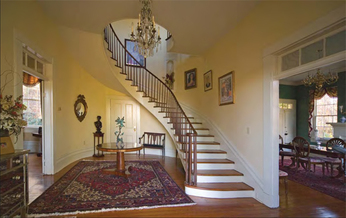 This "geometric stair" is a focal point
This "geometric stair" is a focal pointof the Lee-Darwin-Lacy House in Madison
(Robin McDonald)
Southern Architecture and Preservation
Function Marries Form: Some Early Tennessee Valley Stairways
By Robert Gamble
The breathtaking stairways of antebellum Alabama demanded artistic flair and design. View the beautiful Lee-Darwin-Lacy House of Madison’s geometrical stair, and the unique main and “back hall” stairway of the Woodroof-Crumlish House in Mooresville. The Watkins-Moore-Rhett House’s corkscrew staircase is also a dizzying delight, but most spectacular of all is the tour de force of grace, elegance, and double flights: Barton Hall’s stairway in the Cherokee Vicinity.
Additional Information
To get involved with Alabama’s Preservation:
Since 1994 the Alabama Historical Commission and the Alabama Trust for Historic Preservation have joined forces to sponsor “Places in Peril,” a program that each year highlights some of the state’s significant endangered properties. As awareness yields commitment, and commitment yields action, these endangered properties can be saved and returned to their important place as treasured landmarks.
The “Places in Peril” program has helped to save many important landmarks that might otherwise have been lost. These include the Forks of Cyprus ruins in Florence (listed 1997), the John Glascock House in Tuscaloosa (listed 2001), the Lowe Mill Village in Huntsville (listed 2002), the Coleman House in Uniontown (listed 2003), and Locust Hill in Tuscumbia (listed 2004).
Everyone can play a role to help save those resources that are in peril. Adopt one of the properties. Tell everybody you know that it is important. Write letters of support. Volunteer your time or expertise to the local preservation group. If an endangered property really strikes you, go ahead and buy it! A generous (or even modest) donation to the “Endangered Property Trust Fund” can help statewide.
For more information on the fund or joining the Alabama Trust for Historic Preservation , call 205-652-3497 or visit them online. For additional information on the “Places in Peril” program, visit the Alabama Historical Commission website or contact Melanie Betz at 334-242-3184.
The following articles in the Encyclopedia of Alabama will also be of interest:Multimedia
About the Author
Robert Gamble is the Senior Architectural Historian for the Alabama Historical Commission.
Function Marries Form: Some Early Tennessee Valley Stairways
By Robert Gamble
The breathtaking stairways of antebellum Alabama demanded artistic flair and design. View the beautiful Lee-Darwin-Lacy House of Madison’s geometrical stair, and the unique main and “back hall” stairway of the Woodroof-Crumlish House in Mooresville. The Watkins-Moore-Rhett House’s corkscrew staircase is also a dizzying delight, but most spectacular of all is the tour de force of grace, elegance, and double flights: Barton Hall’s stairway in the Cherokee Vicinity.
Additional Information
To get involved with Alabama’s Preservation:
Since 1994 the Alabama Historical Commission and the Alabama Trust for Historic Preservation have joined forces to sponsor “Places in Peril,” a program that each year highlights some of the state’s significant endangered properties. As awareness yields commitment, and commitment yields action, these endangered properties can be saved and returned to their important place as treasured landmarks.
The “Places in Peril” program has helped to save many important landmarks that might otherwise have been lost. These include the Forks of Cyprus ruins in Florence (listed 1997), the John Glascock House in Tuscaloosa (listed 2001), the Lowe Mill Village in Huntsville (listed 2002), the Coleman House in Uniontown (listed 2003), and Locust Hill in Tuscumbia (listed 2004).
Everyone can play a role to help save those resources that are in peril. Adopt one of the properties. Tell everybody you know that it is important. Write letters of support. Volunteer your time or expertise to the local preservation group. If an endangered property really strikes you, go ahead and buy it! A generous (or even modest) donation to the “Endangered Property Trust Fund” can help statewide.
For more information on the fund or joining the Alabama Trust for Historic Preservation , call 205-652-3497 or visit them online. For additional information on the “Places in Peril” program, visit the Alabama Historical Commission website or contact Melanie Betz at 334-242-3184.
The following articles in the Encyclopedia of Alabama will also be of interest:Multimedia
About the Author
Robert Gamble is the Senior Architectural Historian for the Alabama Historical Commission.
Alabama Mysteries
Murder on Chandler Mountain
By Pam Jones
A deathbed confession reopened the grizzly double homicide case of St. Clair farmer Jacob Lutes and his second wife, Marcella two decades after it occurred. Three men had already spent over twenty years in prison when an ill and elderly John McLemore stated that he and his father-in-law Thomas Mcknight were the actual murderers. Those surrounding the case on Chandler Mountain ask: where does the truth lie?
Additional Information
The following items in the Encyclopedia of Alabama will also be of interest:
About the Author
Pamela Jones is a freelance writer and researcher based in Birmingham. Her particular areas of interest in Alabama history are true crime and the state between the two world wars. She is a history instructor at a Birmingham college and writes corporate histories.
Murder on Chandler Mountain
By Pam Jones
A deathbed confession reopened the grizzly double homicide case of St. Clair farmer Jacob Lutes and his second wife, Marcella two decades after it occurred. Three men had already spent over twenty years in prison when an ill and elderly John McLemore stated that he and his father-in-law Thomas Mcknight were the actual murderers. Those surrounding the case on Chandler Mountain ask: where does the truth lie?
Additional Information
The following items in the Encyclopedia of Alabama will also be of interest:
- St. Clair County
- St. Clair Courthouse (photograph)
About the Author
Pamela Jones is a freelance writer and researcher based in Birmingham. Her particular areas of interest in Alabama history are true crime and the state between the two world wars. She is a history instructor at a Birmingham college and writes corporate histories.
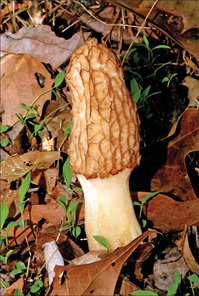 A morel awaits its culinary fate
A morel awaits its culinary fate(W. Mike Howell)
Nature Journal
Lessons in Morelity
By L. J. Davenport
Over thirty species of morels exist nationwide, delighting epicures, drawing curiosity, and even functioning as a source of danger for those who are unfamiliar with some morels’ deadly toxicity. Sprouting from an underground network that shares a hidden, symbiotic relationship with treeroots, it is not until these morels blossom above the surface that we are provided with a hint of the magic going on beneath.
About the Author
Larry Davenport is a professor of biology at Samford University, Birmingham.
Lessons in Morelity
By L. J. Davenport
Over thirty species of morels exist nationwide, delighting epicures, drawing curiosity, and even functioning as a source of danger for those who are unfamiliar with some morels’ deadly toxicity. Sprouting from an underground network that shares a hidden, symbiotic relationship with treeroots, it is not until these morels blossom above the surface that we are provided with a hint of the magic going on beneath.
About the Author
Larry Davenport is a professor of biology at Samford University, Birmingham.
Reading the Southern Past
Two New South Girlhoods
By Stephen Goldfarb
A boisterous childhood from the Black Belt of Wilcox county is delightfully detailed in Viola Goody Liddell’s With a Southern Accent (University of Alabama Press, 1982). Liddell’s large gentry family was hard-hit by the post-World War I depression, but she and her siblings certainly did not suffer from a lack of mischief. A contrast to this rowdy clan is the memoir of Mary Wallace Kirk’s Locust Hill (University of Alabama Press, 1975). Her etchings of the area surrounding Tuscumbia portray a serene and solemn life of southern prosperity.
Additional Information
The following articles in the Encyclopedia of Alabama will also be of interest:
About the Author
Stephen Goldfarb holds a PhD in the history of science and technology. He retired from a public library in 2003.
Two New South Girlhoods
By Stephen Goldfarb
A boisterous childhood from the Black Belt of Wilcox county is delightfully detailed in Viola Goody Liddell’s With a Southern Accent (University of Alabama Press, 1982). Liddell’s large gentry family was hard-hit by the post-World War I depression, but she and her siblings certainly did not suffer from a lack of mischief. A contrast to this rowdy clan is the memoir of Mary Wallace Kirk’s Locust Hill (University of Alabama Press, 1975). Her etchings of the area surrounding Tuscumbia portray a serene and solemn life of southern prosperity.
Additional Information
The following articles in the Encyclopedia of Alabama will also be of interest:
About the Author
Stephen Goldfarb holds a PhD in the history of science and technology. He retired from a public library in 2003.
